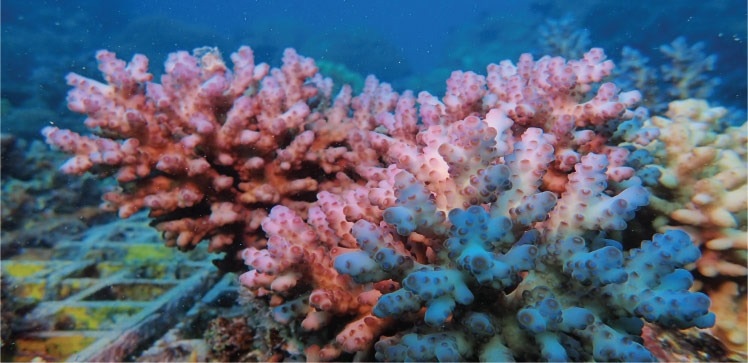Reviewed by Mila PereraSep 26 2022
The construction of a superior-quality genome from a coral specimen reveals an alternate pathway for cysteine biosynthesis in animals and warns against relying too much on model organisms.

While generating a high-quality genome of the coral Acropora loripes (pictured above), KAUST marine scientists discovered for the first time that most animals have an alternative cysteine biosynthesis pathway. Image Credit: © 2022 Australian Institute of Marine Science (AIMS); Jose Montalvo-Proano
Model organisms like fruit flies and mice have offered researchers great insights into the intricacies of cellular biology. These model animals are merely a guide, and it is sometimes risky to generalize the results across animals from researching a selection of model organisms.
Cysteine is a crucial amino acid used in numerous biological activities, such as protein synthesis and metabolism. In animals, cysteine biosynthesis is believed to be created only through the transsulfuration pathway, with the cystathionine β-synthase (CBS) enzyme critical to its production.
Previous research suggested that the CBS gene was lost in corals of the genus Acropora. Scientists believed these corals were unable to produce cysteine and had to rely on symbiotic relationships with algae for it.
We weren’t searching for possible cysteine biosynthesis in Acropora. We were generating a high-quality genome of the coral Acropora loripes as a valuable genomic resource for future research.
Octavio Salazar, King Abdullah University of Science and Technology
Octavio Salazar worked on a Center Partnership Fund project with Principal Investigator Manuel Aranda from KAUST and co-workers from the Australian Institute of Marine Science.
The researchers intended to confirm if the CBS gene was missing after completing the high-resolution genome.
Salazar could not identify any signs of the gene at the locus where it should be present. He and his team were unconvinced that the coral had no other means of producing cysteine.
I started searching the genome for genes encoding for enzymes that looked similar to those in other known cysteine biosynthesis pathways, such as those found in fungi and bacteria. I was quite surprised to find two enzymes in the coral with similarities to a recently identified alternative cysteine biosynthesis pathway in fungi.
Octavio Salazar, King Abdullah University of Science and Technology
The researchers employed yeast mutants that lacked the ability to produce cysteine. They gave them the matching Acropora genes to demonstrate that the enzymes represented by these coral genes could produce cysteine in vivo. The mutants began producing cysteine.
The KAUST team also discovered that both genes were present in all animal phyla except for vertebrates, arthropods, and nematodes, the same three categories from which most animal model organisms originate.
This study proves the value of keeping an open mind when it comes to studying living creatures. Sometimes knowledge can put you in a box; if you analyze data using only what you think you know, you may well miss something. Our Acropora genome will be hugely valuable for future studies and who knows, it could reveal other unexpected details along the way.
Manuel Aranda, King Abdullah University of Science and Technology
Journal Reference
Salazar, O. R., et al. (2022) The coral Acropora loripes genome reveals an alternative pathway for cysteine biosynthesis in animals. Science Advances. doi.org/10.1126/sciadv.abq0304.